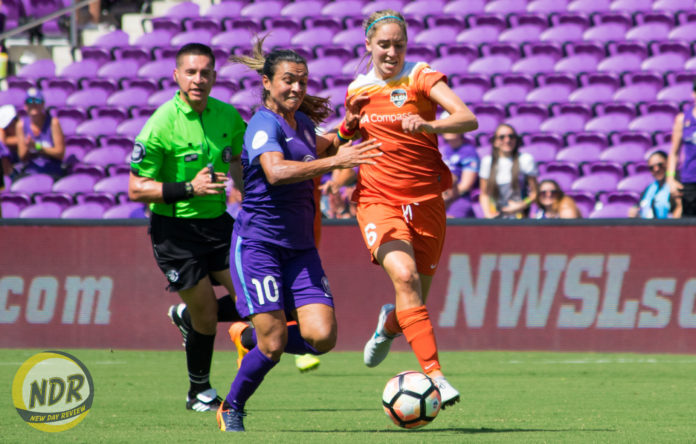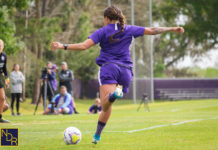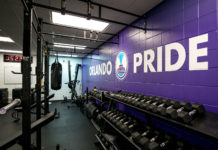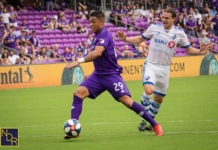
ORLANDO, Fla. – During the Orlando Pride’s 2-0 loss to the Houston Dash on June 24, temperatures reached as high as 95 degrees Fahrenheit. Fortunately for the players, updated mandates by the National Women’s Soccer League that were instituted at the beginning of this month demanded there be at least two water breaks during matches in such heat. In the Pride’s loss, one water break occurred in the 30th minute, the other in the 67th.
But for Pride head coach Tom Sermanni, teams shouldn’t even be playing during the day in Florida because of the dangerously high temperatures.
“I think we’ve all said it that, at 4 o’clock or 3:50 in the summer, in Orlando, it’s not a wise time to play any outdoor sport, particularly our sport,” Sermanni said after training Monday. “It would be much better for the quality of the game, the health of the players and for the spectators to play our games in the evening… [There] are always factors that influence when games are held. And, in the case of us, television plays a big factor in that. And it’s something that we just need to go on with and live with and can’t use [as] an excuse.”
The NWSL entered into an unprecedented three-year media deal with Lifetime before the start of the 2017 season, showcasing one “NWSL Game of the Week on Lifetime” every Saturday at 4 p.m. Orlando and Houston’s match on Saturday was one of those games, and, coincidentally, it involved a player who has already physically suffered from a day-time, high-temperature game.
Houston forward Rachel Daly collapsed from heat illness during a 2-0 loss to the Seattle Reign in Houston on May 27 when temperatures reached the 90s, according to a report by ESPN. She was taken off the field on a stretcher and was sent to the hospital.
In response, the league updated its heat-illness countermeasures, which added guidelines for extreme heat and implemented the usage of more appropriate measurements, and also rescheduled 23 Saturday matches that moved some games to the evening. However, some games — like the Week 10 Orlando-Houston matchup, which was originally scheduled for 4 p.m. — simply had a 10-minute start-time difference to accommodate for the water breaks.
For NWSL managing director of operations Amanda Duffy, she called the safety of everyone involved in an NWSL match “paramount” when the league announced the new heat-illness countermeasures.
“The safety of everyone involved with the execution of NWSL matches, including players, referees and fans, is paramount,” Duffy said in a statement released on June 12. “These are important measures that will help to ensure the safest environment possible at all league matches, and we will continue to evaluate steps that can be taken in the future.”
In the NWSL’s updated hydration regulations, water breaks are required in the 30th and 75th minutes if wet bulb globe temperature (WGBT) readings before each half return results of 82 degrees or higher. Referees can also call for additional water breaks if player safety is deemed at risk.
One of the more significant changes in the updated guidelines was the usage of WGBT readings. Before, the NWSL was using heat-index readings — which factor in just temperature and humidity and calculate for shady areas — to determine if the two water breaks were needed. WGBT readings, on the other hand, take into account more factors: temperature, humidity, wind speed, sun angle and cloud cover (solar radiation). The biggest difference is that WGBT readings are measured in direct sunlight, whereas heat-index readings are not. According to the National Weather Service, a WGBT reading is a “good element to monitor” for work or exercise in direct sunlight.
Furthermore, the National Weather Service also states that direct sunlight in temperatures 90 and above “will stress your body after 15 minutes” and suggests breaks of 45 minutes each hour if exercising in direct sunlight.
But, despite the usage of a more appropriate measurement that allows for more liberal uses of water breaks, players are still competing in undesirable conditions. For Pride center-back Ali Krieger, there still needs to be change.
“Unfortunately, we had to play at 3:50,” Krieger said after the Houston loss. “I still don’t understand that. I think they need to readjust it, in my opinion. You know, I can’t speak for the team or the club or the league, but they need to really, you know, readjust that because it is hot, and taking those water breaks is great, and it’s needed when it’s this hot, but it obviously takes away the momentum of the game a little bit.”
Jarrett Schweim, head athletic trainer of the University of Central Florida’s men’s basketball team, said it takes weeks to acclimate to high temperatures.
“In soccer, you have players coming from Europe, from the Midwest or wherever. It’s not only the heat [they have to adjust to], but the humidity is a very large adjustment,” said Schweim, who served as a certified athletic trainer for the University of Florida’s and Ohio State University’s football teams for three years each. “It takes multiple weeks to adjust to that. It’s not the same, but if you have athletes training in high altitudes, it takes them a while to adjust to the thinness of the air, too.”
For Schweim, a big factor comes down to an athlete’s preparation before competitions. But even when athletes prepare well, any temperature above 90 is a concern.
“A big thing is the preparation of playing each game,” Schweim said. “Say, for example, you have a football player who weighs 250 pounds at the beginning of practice, and he leaves at 244 pounds. That means he lost six pounds of fluid. He needs to get his weight back before going into a competition. Athletes have to do this day in, day out.
“I think there’s an increased risk of playing in high temperatures pretty much in any outdoor spot. The hotter it is, the more risk there’s going to be. Certainly, that’s where the front of it comes into play — gaining those fluids back before, during and after a practice. For me…any time it’s above 90, it’s going to be a concern. Humidity too. Wet bulb is gonna be a good measurement for that.”
Up next on the “NWSL Game of the Week on Lifetime” docket will be a matchup between the North Carolina Courage and Sky Blue FC in Cary, North Carolina, on Saturday at 3:30 p.m. Temperatures are expected to be in the high 80s during the day before dropping to the low 70s in the night.
The NWSL, which provided information used in this article, declined to comment on the record.
For more on how the NWSL is or isn’t adjusting its heat-illness countermeasures, follow Victor Tan on Twitter at @NDR_VictorTan.







[…] improve its scheduling decisions, she said the NWSL is also making progress. Earlier this season, Krieger was critical of the league about scheduling matches in the afternoon in states like Florida and […]
Comments are closed.